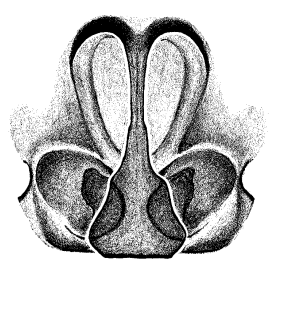Pardosa saturatior Simon, 1937
Description
Palp male: tarsus 1.5 mm long, very dark, black haired. Epigyne with septum, 0.75 mm long. Prosoma chocolate-brown, scarcely covered with grey hairs, lateral bands broken into 3-4 spots. Legs reddish yellow, distinctly annulated. Opisthosoma grey-black with very vague pattern.
Body length male: 7.0-8.0 mmBody length female: 7.8-9.5 mm
Distribution
Phenology
| Jan | Feb | Mar | Apr | May | Jun | Jul | Aug | Sep | Oct | Nov | Dec |
 |  |
Figures
Distribution List
"No references" does not mean that the species does not occur in this country, but that we have not yet inserted the reference for it. We are working on it.
References
Arnold K (2001) Beitrag zur Spinnenfauna (Arachnida, Araneae) des Fürstentums Liechtenstein. Berichte der Botanisch-Zoologischen Gesellschaft Liechtenstein-Sargans-Werdenberg 28: 211-244 ![]()
Branco V V, Morano E, Cardoso P (2019) An update to the Iberian spider checklist (Araneae). Zootaxa 4614: 201-254 ![]()
Chiarle A, Kronestedt T, Isaia M (2013) Courtship behavior in European species of the genus Pardosa (Araneae: Lycosidae). Journal of Arachnology 41: 108-125 ![]()
Kostanjšek R, Kuntner M (2015) Araneae Sloveniae: a national spider species checklist. ZooKeys 474: 1-91 ![]()
Pantini P, Isaia M (2019) Araneae.it: the online catalog of Italian spiders, with addenda on other arachnid orders occurring in Italy (Arachnida: Araneae, Opiliones, Palpigradi, Pseudoscorpionida, Scorpiones, Solifugae). Fragmenta Entomologica 51: 127-152 ![]()
Schenkel E (1925) Beitrag zur Kenntnis der schweizerischen Spinnenfauna. Revue Suisse de Zoologie 32: 253-318 ![]()
Tongiorgi P (1966a) Italian Wolf spiders of the genus Pardosa (Araneae: Lycosidae). Bulletin of the Museum of Comparative Zoology 134: 275-334 ![]()
WSC (2025) World Spider Catalog. Version 26. Natural History Museum Bern, online at http://wsc.nmbe.ch (28.2.2025) doi: 10.24436/2 ![]()
Updates
| 04-06-2024 | Distribution update | Detail |



